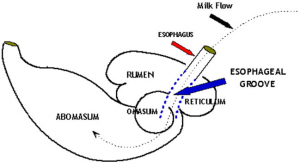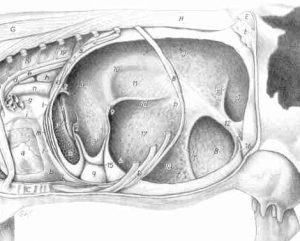29 Forestomach activity and function
The rumen is nonfunctional at birth and has to develop over time. In the neonate, milk bypasses the rumen by going through the esophageal groove.
 This is a functional change in the esophagus created by high levels of vasopressin. When the calf suckles, the suckling action and milk proteins stimulates formation of the groove, shifting milk past the rumen and reticulum. This avoids any accidental fermentation of milk. If a calf drinks from a bucket or if the groove doesn’t form, occasionally some milk will end up in the rumen and cause bloating. These calves are known as “rumen drinkers”.
This is a functional change in the esophagus created by high levels of vasopressin. When the calf suckles, the suckling action and milk proteins stimulates formation of the groove, shifting milk past the rumen and reticulum. This avoids any accidental fermentation of milk. If a calf drinks from a bucket or if the groove doesn’t form, occasionally some milk will end up in the rumen and cause bloating. These calves are known as “rumen drinkers”.
Over time, the rumen acquires microbes (from the diet and the environment), begins to expand (a great deal) and acquires the papilla. The papilla development occurs in direct relation to the intake of grains rather than hays. Calves eating too much milk or poor quality grain do not develop as healthy a rumen as those on good quality and adequate levels of grain.

The rumen is also called a fermentation vat. Once the calf is weaned and the rumen has begun developing, food enters via the esophagus and directed into the rumen. The well functioning rumen has distinct layers. Yesterday’s hay and grains are already somewhat liquefied and sink to the bottom. Gases float to the top and today’s hay floats in the middle. These layers can be distinguished on firm palpation through the body wall. Today’s hay will be regurgitated and chewed more before it starts to sink. Once in the fluid layer, the older feeds become microbial food and will be digested by the bugs. Larger particles will be recirculated in the rumen until further digested. When the particles are small enough, they will move through the reticulum and into the reticulo-omasal orifice. The omasal leaves will absorb as much water as possible, sending the thickened chyme into the abomasum.
A similar process occurs in small ruminants and in camelids. Camelids have 3 chambers, named C1, C2 and C3. C3 is the true stomach while C1 acts like the rumen and C2 like the reticulum.
Rumen rolls or rumen contractions occur every 1-3 minutes in a healthy animal. These can be felt through palpation of the paralumbar fossa and heard with a stethoscope. The brainstem and vagus nerve control rumen activity. It can be altered by changes in content (eating river rocks is bad for rumen activity), pain, pH changes and vagal nerve dysfunction. Hormones also appear to play a role, as seen with pregnancy indigestion.
The rumen should contain large and small motile protozoa as well as a multitude of mostly gram positive bacteria. pH levels are very important to keep the appropriate flora balance and for normal rumen activity. Rumen pH needs to stay between pH of 6 and 7 for best function. Rumen pH <5.5 causes significant disruption on rumen flora. Extra chewing (enough fiber) helps by producing buffering saliva. Dietary rumen buffers can help as can certain additives.
Resources
Development of the rumen – how feedstuffs affect rumen papilla development
Rumen microbial fermentation – nice overview; you can skip the rainforest bit
How the rumen works ebook – well done and more than you need right now
Rumen physiology and rumination – CSU- always has good stuff

